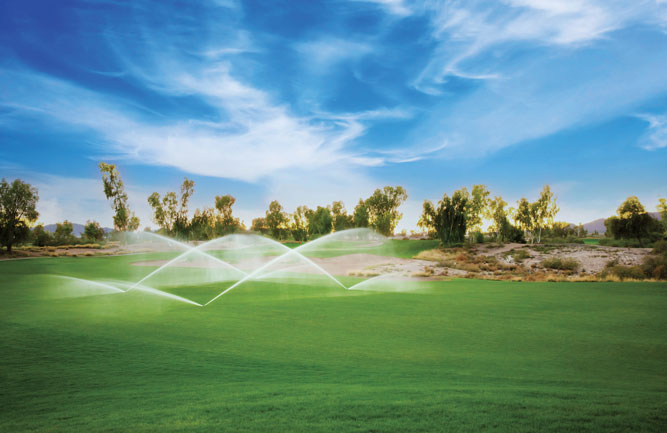Experts share tips to avoid improper irrigation shutdowns

Ross Miller
Unfortunately, improper irrigation shutdowns can lead to devastating issues that will compound over time, including a higher frequency of breakdowns in all system components—from irrigation heads and pipes to pump stations and satellites.
As director of agronomy at the Country Club of Detroit, Ross Miller, CGCS, has witnessed these negative impacts firsthand.
“Improper irrigation shutdowns can cause a domino effect of issues, from exponentially higher than average costs for repair and maintenance of all facets, to subsequently higher labor and materials costs,” he says. “These issues then lead to challenges in the field, with regards to optimizing courses’ playability to the highest standards possible, while also overcoming budgeting ramifications.”
To avoid improper irrigation shutdowns in the first place, Miller advises superintendents to create systematic checklists in conjunction with all purveyors, such as their respective irrigation system providers and pump manufacturers. They have superintendents’ best interests in mind, along with vast knowledge of their equipment.

Proper winterization procedure is crucial to keep golf course irrigation systems running smoothly year round. (Photo: Hunter Industries)
“This checklist should include compressor pressure during blowouts (40 PSI) and a process for draining and winterizing their pump station,” he adds. “It should also include the process for winterizing irrigation satellites so that pests won’t inhabit the irrigation system during the winter, leading to issues for the next season.”
Looking to the future, Miller believes improper irrigation shutdowns will decrease as more resources are available online and through vendors as they strive to educate their stakeholders.
“Furthermore, as each superintendent focuses on the consequences of improper irrigation shutdowns and fully understands each of them, they’ll continue to improve their shutdown processes,” he stresses. “And, in doing so, they’ll be able to optimize their irrigation system and extend its lifespan, ensuring they can maintain their operation’s largest infrastructure asset on a long-term basis.”

Carl Eberts
Hunter Industries
Carl Eberts
Category Manager, Golf
As we approach the colder seasons, superintendents need to stay proactive, with regards to managing their irrigation systems and courses. If action is not taken to properly shut down irrigation, they’ll risk severe damage to their entire system. The main pipe, valves, swing joints and rotors are susceptible to damage if excess water remains in the system and freezes. In addition, compressed air during the winterization process can damage other parts of the system, such as water meters, flow sensors and backflow devices. To avoid this, superintendents should ensure the air connection is downstream, in relation to these sensitive components. I recommend hiring a licensed contractor to perform the blowout process, due to the risks involved. Once pressure is completely expelled from the system, superintendents must also ensure that entry points for debris are never left open throughout the winter.

Chris Dunlop
Rain Bird
Chris Dunlop
Golf Specification Manager, Western U.S.
As winter approaches, it’s essential for superintendents to safeguard their irrigation systems. For winterization success, they must have a well-defined plan that focuses on compressor selection, preliminary actions, final preparation and methodical movement. Each superintendent’s compressor should be around 30 to 40 percent of their pump station’s capacity and equipped with a pressure regulator set between 40 and 65 PSI. Superintendents must close their pump discharges, open their drain/vacuum valves and attach quick coupler keys several days before winterization occurs. They should also identify efficient compressor tap locations. On the day of winterization, superintendents should close air relief valves while leaving drain valves open for water ejection. They should connect compressors with steel connections and long hoses to dissipate heat. Superintendents must activate elevated stations farthest from their compressors prior to progressing through their pipe networks toward their compressors and finish at low points. Finally, close all drain valves and open all air relief valves, as control systems should remain operational.

Matt Campbell
Arborjet | Ecologel
Matt Campbell
Southeast Regional Technical Manager
The best solution to any irrigation malfunction of any kind is being proactive. In most cases, while working with irrigation systems, the most successful approach lies with agronomy programs. Superintendents must create a moisture-managing buffer for stressful times. They should also understand their nitrogen curves’ residual effects on plants during unexpected irrigation shutdowns. In addition, they must implement a daily moisture curve program — as soil moisture constantly changes throughout the day — to relieve excess nitrogen volatility, which may harm plants. Agronomic programs like these not only feature moisture-managing solutions, but also allow superintendents to overcome any potential plant health care risks that arise during unintentional irrigation shutdowns. By utilizing products like Hydretain, water will be readily available to plants throughout the inconsistencies of the moisture curve, thereby providing a buffer that lessens the risk of plant damage, which would have otherwise occurred during unexpected irrigation shutdowns.

Brian Hurley
Ewing Outdoor Supply
Brian Hurley
National Golf Sales Manager
A properly functioning irrigation system ensures that golf course turf remains healthy, as the appropriate amount of water is consistently applied. However, if improper shutdowns occur, turf can become vulnerable to poor coverage and playing conditions. Given the cost of irrigation systems, superintendents must strive to maintain them for as long as possible. After all, proper functioning is critical to each irrigation system’s longevity. Most golf irrigation and pumping systems have plenty of advanced offerings that superintendents can utilize to avoid an improper shutdown. Aside from technology, by implementing proper flow management, water usage and control, superintendents can ensure their irrigation systems work in concert with their particular goals and schedules, as well as their team members’ schedules. In turn, golfers will have the best possible playing conditions whenever they golf on their courses.
Toro

David Angier
David Angier
Marketing manager
When superintendents’ irrigation systems unexpectedly malfunction, the results can be detrimental. It won’t take long for extreme temperature or precipitation conditions to create patchy courses. Consequently, if irrigation shutdowns aren’t addressed in a timely, effective manner, their effects can be challenging and expensive to repair. To minimize the stress of potential issues on their courses, superintendents must use reliable technology in their irrigation management and winterization plans. For instance, as they ease out of the busy season, they can utilize technology to report which areas need the most attention or maintenance. Additionally, by using a year-round system that provides immediate alerts and accurate location information, superintendents will quickly determine their problems’ sources. And, by utilizing a system that continuously monitors equipment and collects data — like voltage and amperage information — they will understand their irrigation systems’ overall health. Therefore, they’ll be able to forecast potential system issues and address problems proactively so that they won’t escalate.












